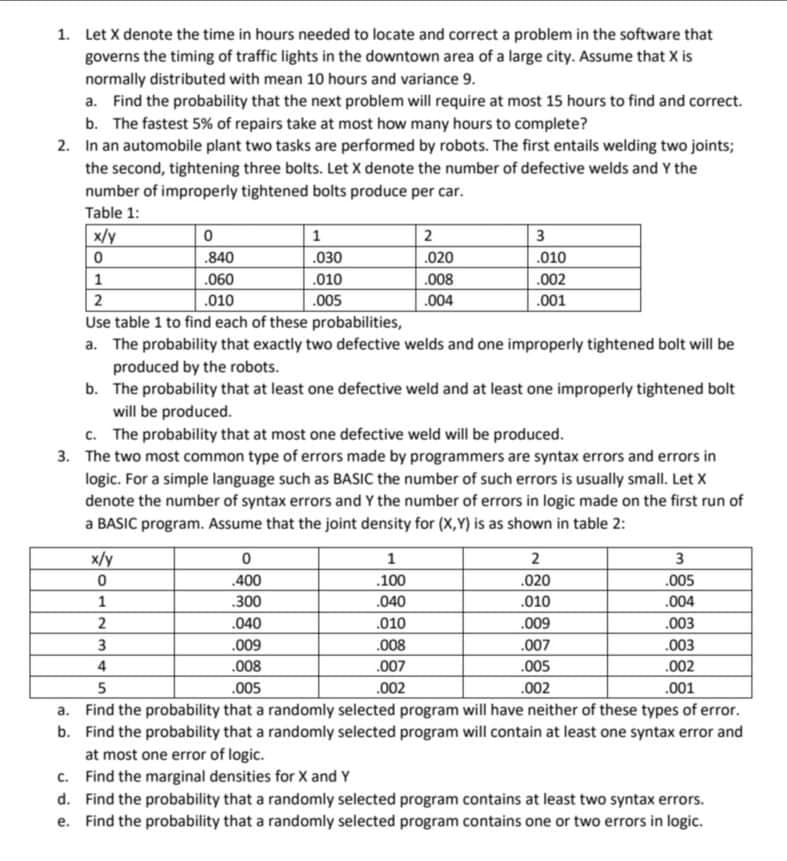Use table 1 to find each of these probabilities, a. The probability that exactly two defective welds and one improperly tightened bolt will be produced by the robots. b. The probability that at least one defective weld and at least one improperly tightened bolt will be produced. c. The probability that at most one defective weld will be produced.
Use table 1 to find each of these probabilities, a. The probability that exactly two defective welds and one improperly tightened bolt will be produced by the robots. b. The probability that at least one defective weld and at least one improperly tightened bolt will be produced. c. The probability that at most one defective weld will be produced.
Glencoe Algebra 1, Student Edition, 9780079039897, 0079039898, 2018
18th Edition
ISBN:9780079039897
Author:Carter
Publisher:Carter
Chapter10: Statistics
Section10.4: Distributions Of Data
Problem 19PFA
Related questions
Question
100%
(g) answer #2

Transcribed Image Text:1. Let X denote the time in hours needed to locate and correct a problem in the software that
governs the timing of traffic lights in the downtown area of a large city. Assume that X is
normally distributed with mean 10 hours and variance 9.
a. Find the probability that the next problem will require at most 15 hours to find and correct.
b. The fastest 5% of repairs take at most how many hours to complete?
2. In an automobile plant two tasks are performed by robots. The first entails welding two joints;
the second, tightening three bolts. Let X denote the number of defective welds and Y the
number of improperly tightened bolts produce per car.
Table 1:
x/y
2
3
.840
.030
.020
.010
.060
.010
.008
.002
2
.010
.005
.004
.001
Use table 1 to find each of these probabilities,
a. The probability that exactly two defective welds and one improperly tightened bolt will be
produced by the robots.
b. The probability that at least one defective weld and at least one improperly tightened bolt
will be produced.
c. The probability that at most one defective weld will be produced.
3. The two most common type of errors made by programmers are syntax errors and errors in
logic. For a simple language such as BASIC the number of such errors is usually small. Let X
denote the number of syntax errors and Y the number of errors in logic made on the first run of
a BASIC program. Assume that the joint density for (X,Y) is as shown in table 2:
x/y
1
2
3
400
.100
.020
.005
300
.040
.010
.004
.040
.010
.009
.003
3
.009
.008
.007
.003
4
.008
.007
.005
.002
.002
.005
.002
.001
a. Find the probability that a randomly selected program will have neither of these types of error.
b. Find the probability that a randomly selected program will contain at least one syntax error and
at most one error of logic.
c. Find the marginal densities for X and Y
d. Find the probability that a randomly selected program contains at least two syntax errors.
e. Find the probability that a randomly selected program contains one or two errors in logic.
Expert Solution
This question has been solved!
Explore an expertly crafted, step-by-step solution for a thorough understanding of key concepts.
Step by step
Solved in 4 steps with 3 images

Recommended textbooks for you

Glencoe Algebra 1, Student Edition, 9780079039897…
Algebra
ISBN:
9780079039897
Author:
Carter
Publisher:
McGraw Hill

Glencoe Algebra 1, Student Edition, 9780079039897…
Algebra
ISBN:
9780079039897
Author:
Carter
Publisher:
McGraw Hill